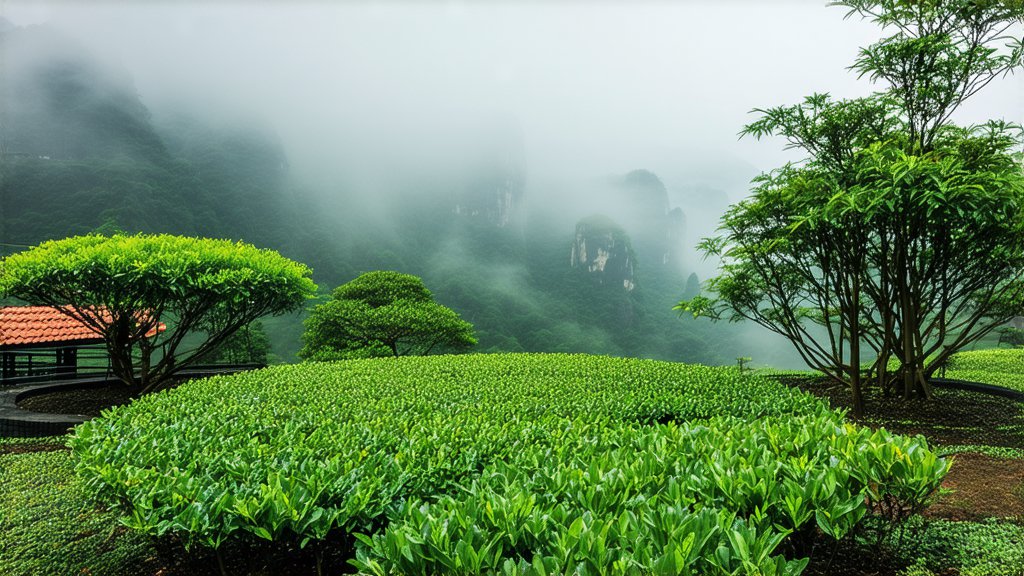
Nestled within the verdant hills of Anhui province lies a treasure trove of tea history and craftsmanship that has been perfected over centuries. Among the myriad varieties of Chinese tea, Huangshan Maofeng stands out as a quintessential representation of the country's revered yellow tea category. This article embarks on a journey to explore the rich heritage, intricate production process, and the art of appreciating this golden elixir, inviting international readers to partake in its timeless allure.
Historical Roots and Cultural Significance
The origins of Huangshan Maofeng, also known as "Yellow Mountain Fur Peak," can be traced back to the Tang Dynasty (618-907 AD), a period marked by flourishing arts, culture, and innovation in China. Legend has it that this tea was discovered by a Buddhist monk who, after accidentally allowing freshly picked green tea leaves to undergo a slight fermentation process due to damp weather conditions, stumbled upon its unique flavor profile. This serendipitous event led to the development of what we now know as yellow tea, with Huangshan Maofeng becoming one of its most celebrated expressions.
Over the centuries, Huangshan Maofeng has been associated with the literati and scholars, often featured in classical poetry and painting as a symbol of refinement and natural beauty. Its name, literally meaning "Fur Peak" from the Yellow Mountains, reflects both its geographical origin and the fine, downy covering on its young leaves, which resembles the soft fur of a peak shrouded in mist.
Varieties and Classification
While Huangshan Maofeng is the most renowned among China's yellow teas, it is important to note that the category encompasses several other regional specialties, each with distinct characteristics yet sharing a common thread of gentle fermentation that sets them apart from green and black teas. Unlike the more widespread green teas, which are quickly fried or steamed to prevent oxidation, yellow teas undergo a controlled oxidation process that imparts a subtler, sweeter flavor and a distinctive golden hue to the brewed liquor.
Among these varieties, Mengding Huang Ya from Sichuan province and Junshan Yinzhen from Hunan province also hold esteemed positions, but none capture the imagination quite like Huangshan Maofeng. Its unique terroir—the combination of high altitude, cool climate, and fertile soil found in the Yellow Mountain region—contributes to the tea's exceptional quality and complexity.
The Art of Crafting Huangshan Maofeng
The production of Huangshan Maofeng is an art form that requires meticulous attention to detail and a deep understanding of nature's rhythms. The process begins in early spring when only the youngest, most tender buds and leaves are handpicked. These are then carefully spread out to wither under the sun or indoors, allowing for a slow, even fermentation that transforms the vibrant green leaves into a warm, golden color.
Next comes the fixation stage, where the withered leaves are lightly stir-fried or pan-fried to halt further oxidation while preserving their delicate flavors. This step is crucial as it locks in the characteristic chestnut aroma and sweet taste that define Huangshan Maofeng. Following this, the leaves undergo a rolling process to shape them into their distinctive twisted form before being dried to remove excess moisture and ensure longevity.
A Symphony of Sensory Delights: Tasting Huangshan Maofeng
To truly appreciate Huangshan Maofeng, one must engage all senses in the tasting experience. Begin by observing the dry leaves, which should exhibit a uniform golden-yellow hue interspersed with hints of green. As you measure approximately 3 grams per 150ml of hot water (around 80°C or 176°F) into your gaiwan or teapot, allow the leaves to unfurl gracefully, releasing their enchanting aroma.
The first infusion reveals a light, floral fragrance with subtle notes of jasmine and orchid, while subsequent infusions deepen into a comforting chestnut and honey profile. The liquor itself is a luminous amber, reflecting the careful balance achieved during fermentation. On the palate, Huangshan Maofeng offers a smooth, velvety texture followed by a lingering sweetness that invites contemplation.
To fully savor the tea's nuances, take small sips, allowing the liquid to coat your tongue and fill your mouth before swallowing. Pay attention to how the flavors evolve with each successive brew, as good quality Huangshan Maofeng can be steeped multiple times without losing its charm.
Conclusion: A Timeless Treasure
In a world increasingly dominated by fast-paced lifestyles and mass production, Huangshan Maofeng serves as a poignant reminder of the beauty inherent in tradition, patience, and harmony with nature. Each cup tells a story of centuries-old wisdom passed down through generations, inviting us to pause, reflect, and reconnect with the simple pleasures of life. For those seeking a gateway into the profound depths of Chinese tea culture, Huangshan Maofeng stands as a golden key, unlocking a universe of flavors and experiences waiting to be discovered.